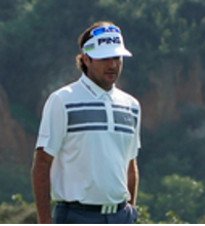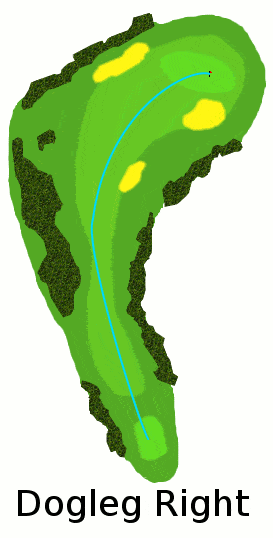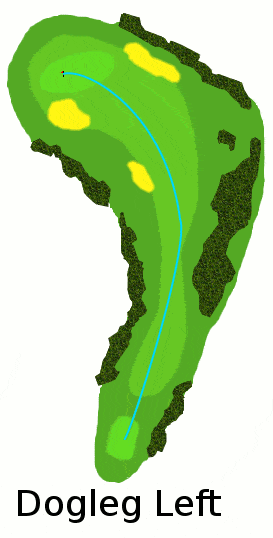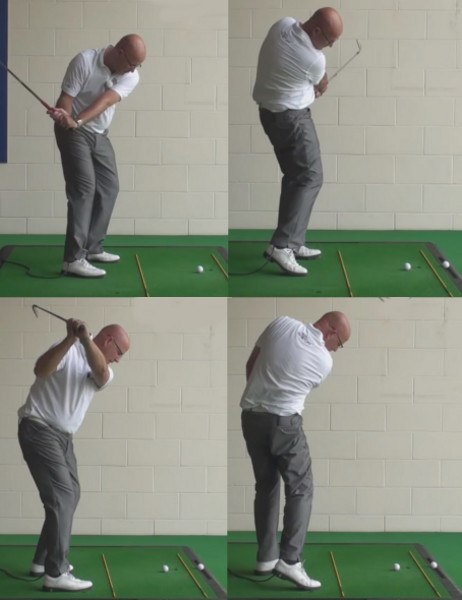
Bubba Watson is one of the new generation shot making golf pros that can work the golf ball left to right (fade) and right to left (draw).
Did you know that while professional golfers are the most accurate players on earth, they almost never hit the ball straight?
That's right, nearly every shot a pro golfer hits curves at least a little bit. Perhaps the “straightest” hitter of them all, Ben Hogan, famously said, “You only hit a ball straight by accident. The ball is going to move right or left every time you hit it, so you had better make it go one way or the other.”
And that's exactly what pros do. Highly skilled golfers can bend the ball to their will, making it turn left-to-right (fade) or right-to-left (draw) depending on the situation. The mechanics of hitting fades and draws are fairly simple; mastering them is another matter.

There's little point in hitting intentional curveballs unless you understand which situations call for which shots. The pros have this figured out pretty well.
Why It's Important
All things being equal, a perfectly straight shot would be preferable in most circumstances. But if Hogan couldn't consistently pull it off, it can't be done.
Besides, few golf holes fall in a straight line. When a hole doglegs left or right, it's generally preferable to hit a tee shot that bends in the same direction. This presents a wider margin for error, since the ball flies and rolls along the path of the fairway.
The same principle applies on shots into greens that are protected by hazards. For instance, if the front of the green is open and the pin placed behind a bunker to the right, a shot directly at the flag risks falling short into the sand. A left-to-right shot, however, will curve around the bunker toward the hole.
Who You Should Watch
For better or worse, modern equipment has made it more difficult – and less necessary – to shape shots. The likes of Hogan, Sam Snead, Lee Trevino and Seve Ballesteros were shotmaking magicians, curving the ball at all sorts of angles to reach tucked pins. Today's pros are able to turn shots when needed, just not to the same degree.
Corey Pavin, now playing on the Champions Tour, built a career as a shot-shaping wizard out of necessity -- at 5'9” and 155 pounds, he's one of the shortest hitters of the modern era. But his remarkable ability to play around obstacles helped Pavin overcome a lack of distance and win 15 times on the PGA Tour, including the 1995 U.S. Open.
Watch how Pavin attacks awkward pin placements from long yardage. When he can't carry the ball onto the green, he'll play a low-running draw that bounces on. He gets extra distance with the driver in much the same way, turning the ball to fit the dogleg for maximum roll.

Among the younger set, Tiger Woods, Phil Mickelson, Bubba Watson and Sergio Garcia carry full arsenals of fades and draws, and usually choose the shape that works best for the given shot. Other pros prefer to work the ball in one direction most of the time, feeling that this enhances consistency.
To understand the pros' approach, watch them set up to tee off on a dogleg right, for instance. Most will hit a fade, aligning their bodies down the left side of the fairway and curving the ball toward the center. Those who are more comfortable with a draw will aim to the right – sometimes in the rough or at a hazard – and turn the ball back to safety.
Playing a draw on a left-to-right hole isn't ideal, however. If the ball doesn't curve, it may end up in the rough or hazard. If it does draw and hit the fairway, it could run out of short grass quickly. The same goes for playing a left-to-right shot on a hole the bends the opposite direction.
Pros will also utilize fades and draws to either minimize or accentuate the effects of wind. For instance, they might hit a fade against a right-to-left wind to produce a straight shot. Conversely, they may choose a draw to help the ball fly farther across the wind.
Apply It to Your Game
- Dogleg-right par 4 or par 5
- Approach shot to a pin on the right side of the green
- Against a right-to-left crosswind to produce a straight shot
- With a left-to-right crosswind to maximize distance
- Downwind to maximize carry (a fade typically flies higher than a draw)
First, you must know how to hit a fade or a draw. Here's a basic guide on when to use each.
Hit a fade:

Watching the Pros – Shaping Shots
For the average golfer, there is much that can be gained from watching the best players in the world do what they do best. If you can find time in your schedule to watch professional golf on television from time to time, your own game will benefit as a result. The players who reach the top of the game have highly refined skills, both from a physical and mental perspective. Even if you only pick up one or two tips from watching a pro tournament, it will have been worth your time. Besides, in addition to helping your game, watching pro golf events such as the four major championships is simply great entertainment.
Each time you watch a golf tournament on TV, try to pick out one element of the game to watch for specifically. That way, instead of just seeing the players hit great shots over and over again, you will begin to notice the subtleties in how they are managing to get the ball so close to the hole. One element of the game in particular that you can watch for is how the pros shape shots. Most amateur players simply aim at the hole and hope for the best, but the top pros are very specific about the way they curve the ball in order to reach the target. Playing both right to left and left to right shots during the same round enables professional golfers to get close to the hole more frequently – which means more birdies in the end.
At this point, you might be thinking that controlling the shape of your shots is a skill that is out of your reach. While it is true that shot shaping is an advanced technique in golf, you shouldn't write yourself off so easily. Even players with relatively high handicaps can learn the basics of shot shaping, which can at least help you get out of trouble spots on the course, if nothing else. Settling for the current state of your game is never going to allow you to lower your scores. Adding skills like the ability to shape shots will open up a whole world of new possibilities in your game.
It is important to understand that you don't have to copy the swing technique of the professionals you watch in order to learn from their games. Most of the time, emulating the swing of your favorite pro golfer is only going to lead to disappointing results. You should stick to the basics of your own swing and simply make minor changes along the way as necessary to improve your results. So, when it comes to shaping shots, don't overhaul your entire swing to learn how to hit a draw or a fade – instead, make small tweaks to your setup and backswing to generate a variety of ball flights.
All of the instruction contained below is based on a right handed golfer. If you play left handed, please reverse the directions as necessary.

A Shopping List
Before you head to the range to start learning how to shape your shots, you should have a good idea of which shots you want to develop. You are never going to have 'every shot in the book' in your arsenal, but you should have a nice variety so you can deal with just about everything the course throws at you. All golfers have a go-to shot that is their favorite ball flight to use in most situations - and that is okay. You don't need to vary your flights on every single shot throughout the round. In fact, it is best if you have one flight that you use for 80% or so of your swings. Changing up your ball flight on every single shot will make it hard to be consistent, and good golf is all about consistency.
Below is a 'shopping list' of four shots that you want to have your bag. As long as these four ball flights are available to you when you need them, the scores you write on the card should steadily begin to fall.
- Your go-to shot. As mentioned above, this is the main shot that you will use during each round that you play. It doesn't particularly matter what kind of shot this is, as long as it repeats time and time again. Like to play a draw? Go ahead. Prefer a fade? No problem. The important point is that you can hit this shot on command, any time you want. You don't want to plan for your go-to ball flight only to look up to see the ball curving the other way. While you are never going to hit great shots with each and every swing, you should be able to regularly curve the ball in the intended direction. The best way to determine your go-to shot is simply to head to the driving range and make some swings. Most likely, your natural ball flight will reveal itself after only a handful of shots. While hitting these shots, don't try to do anything to your swing regular swing technique - just hit the ball and watch it fly.
- An opposite shot. Now that you know which way your ball is going to curve naturally, you want to develop the ability to turn it the other way when necessary. This is probably going to be your greatest challenge when it comes to ball flight control. Most golfers have trouble transitioning from a fade to a draw or vice versa, so you can expect to spend some significant range time working on this skill. You don't want to radically change your swing to the point of ruining your go-to shot, but you will need to alter it enough to generate the ball flight you desire. Having the ability to counter your regular ball flight will make you a better player because you will have the option to match the @shape of your shots to the hole you are playing.
- A high shot. Controlling your shot shapes is not just about going right and left, but also about going high and low. The ability to hit the ball high is important because it enables you to stop the ball quickly in firm conditions. Also, a high shot is more able to access a front hole location. Professional golfers are particularly adept at hitting the ball high because they play on so many hard, long golf courses. You might not ever be able to hit the ball as high as your favorite tour pro, but even moving it a few more feet into the air will give you more control when the ball lands on the green.
- A low shot. Not surprisingly, the last shot you need to add to your arsenal is a low ball. Low ball flights are great for getting to back hole locations, and they can also come in handy for dealing with windy conditions. All golfers should be able to hit the ball low on command because hitting low shots makes it easier to get your swing under control when you are having a bad round.
If you can walk out onto the golf course with each of these four items checked off of your 'shopping list', you should be in line for a great round of golf. As you make decisions throughout the round, you can lean on your go-to shot in most circumstances, while sprinkling in the other shots as needed. Good golfers make good decisions, and it is easier to make those good decisions when you have the right shots in your bag to employ throughout the day.

Reversing Your Pattern
The shot that you select as your go-to ball flight should require very little refinement. While you will need to hit plenty of balls on the driving range to master your swing, that ball flight won't take much in the way of development. The same cannot be said for hitting the reverse of your regular shot. In order to hit a fade when you normally hit a draw, or vice versa, you will have to make some tweaks to both your set up and your swing technique.
To learn how to create the opposite of your typical ball flight, review the information below.
- Turning a fade into a draw. When a fade is your regular flight, you should be able to create a draw by modifying how you stand over the ball at address and making one key adjustment to how you swing the club. To start, you will want to close off your stance slightly at address. That simply means you are going to move your left foot just a little bit closer to the ball while dropping your right foot back slightly. The exact amount you want to change your stance will depend on how big of a draw you need to create, so experiment with various stances on the range and see what kind of draws they produce. Also, try quieting down your lower body during the transition of your swing. If you can keep your legs quiet early in the downswing while you give your arms a head start, you should be able to 'cover' the ball better at impact. The combination of a slightly closed stance and a quieter lower body should be all it takes to transform a fade into a useful draw.
- Turning a draw into a fade. Players who favor a draw often think the right to left ball flight is the only one they need - but hitting a fade is a valuable skill to possess. If you happen to hit a draw as your go-to shot, be sure to put in the time necessary to teach yourself the fade. To start hitting a fade, to the reverse of above and open your stance to the target slightly. Move your left foot away from the ball by a couple of inches, and get your right foot just a bit closer. Next, take the club back to the outside during the takeaway to put the club above the normal swing path. By creating an outside-in path early in the backswing, you will make it more likely that a fade will be the result. Create more room between your body and your hands within the first few inches of the swing, and make sure your hands are high at the top of the backswing. Combine that steeper backswing with an open stance and you should see the ball turn left to right more often than not.
Realistically, the changes that you need to make to your swing in order to turn a draw into a fade, or a fade into a draw, are relatively simple. The difference between those two ball flights is only a matter of a few degrees, so the two swings will actually look very similar even if you watched them on a slow-motion camera. However, it is still going to take plenty of practice in order to master the ability to hit a reverse ball flight on command. Since it goes against your natural swing instincts, hitting an opposite ball flight is something that will never be completely comfortable. For that reason, be sure to spend a significant percentage of your practice time working on this skill so you can be confident when the time comes to use it during a round of golf.

Hit It High
As mentioned above, hitting the ball high is a skill that is desirable in golf for a number of reasons. Whether you play on firm golf courses and want to stop the ball quick, or simply need to hoist it up into the air over a tree, a high ball flight will come in handy regularly. Of course, it will only come in handy if you are able to hit it successfully. Use the three tips below to turn your regular ball flight into one that soars through the air.
- Move the ball up in your stance. Slide the ball slightly forward in your stance to add elevation to the shot. This is a very simple tip, but that doesn't mean that it is ineffective. In fact, most of what you will do on the golf course to alter your ball flight comes down to simple adjustments. If you watch any pro golfer get ready to hit the ball high, you can be sure they will have moved the ball up in their stance prior to starting the swing. You should follow their lead and do likewise.
- Add right hand release. Go ahead and use your right hand a little more aggressively through impact when you want to hit the ball high in the air. Not only will this increase the effective loft of the club, it will also add backspin to the ball, which helps the ball stay in the air longer. You don't want to use too much right hand in your regular swing because it can make it difficult to strike the ball cleanly. However, using a little extra bottom hand when you wish to throw it high in the air is a worthy strategy to take.
- Stay down in your stance. There are a lot of things in golf that seem backward, and this is one of them - if you want to hit the ball high, you need to stay low in your stance. You want to maintain your knee flex through impact, and make sure your head and shoulders stay down through the shot. It is tempting to stand up near impact because you want to help the ball into the air, but lifting your body up will actually cause the ball to remain lower to the ground. Stay down through your swing and you will have more success sending the ball high in the sky.
Whatever you do, don't swing super hard when trying to hit the ball high. Sure, it might seem like you have to swing hard in order to hit a high ball flight, but that simply isn't the case. Swing speed helps, but your trajectory is more about launch angle and quality of contact than it is raw power. Swinging hard will only get you in trouble with your fundamentals, so take it easy and strike the ball as clean as you can.

Hit It Low
You might think that hitting the ball low would just the opposite of hitting it high, but there is actually a little more to it than that. Just as with the points above, you will need to modify your technique in order to hit low shots. Every golfer trying to make a living playing the game is able to create a low shot when necessary, and you would benefit from possessing the same skill. The three tips that follow will help you hit a hard, low ball flight that can be used to conquer a number of different scenarios.
- Swing softer. Backspin is your enemy when you want to hit the ball low. Shots with a lot of backspin tend to climb high into the air, so you want to keep the rate of backspin to a minimum on your low shots. Since faster swings lead to higher spin rates, the best way to keep the ball low to the ground is to make a softer swing. Simply by making your normal swing at a reduced speed, you can effectively lower the trajectory. Of course, you won't hit the ball as far in the air, but that is a trade work making when a low shot is the right one for the situation.
- Two extra clubs. Instead of reaching for one extra club when hitting a low shot, try using two extra clubs so you can swing softly with no fear of coming up short. For example, if you are facing a 160 yard shot that you would like to hit low, and a six iron is your 160 club, consider reaching for a four iron. This might seem like a lot of stick at first, but remember that the carry distance is going to be significantly reduced through your use of a softer swing.
- Ball back in your stance - but not too far back. Most golfers know that it is a good idea to move the ball back in your stance when you want to hit a low shot. However, moving the ball too far back in your stance can promote backspin, which is exactly what you are trying to avoid. As a compromise, try placing the ball in the middle of your stance, equal distances from your right foot and left foot. This positioning will make it easy to strike the shot cleanly while still enabling you to keep the spin rate down. The perfect ball position will vary slightly for each player, so experiment with your game until you dial it in just right.
You should be practicing low shots as a regular part of your normal practice routine. They are great for hitting into the wind, or playing approach shots to back hole locations. Also, when you are faced with a narrow fairway that is guarded by dangerous hazards on both sides, a low ball off the tee might be the perfect choice to keep you in play.
Professional golfers are professionals for a reason - they can hit a variety of shots, and they can hit them under pressure. Even if you aren't a professional golfer, you can still work on your own ability to turn the ball from side to side, and to hit it high and low. The golf course suddenly opens up when you have more than one shot available to you, so invest the time to learn new shot shapes and you will be rewarded with some of the best golf of your life.






